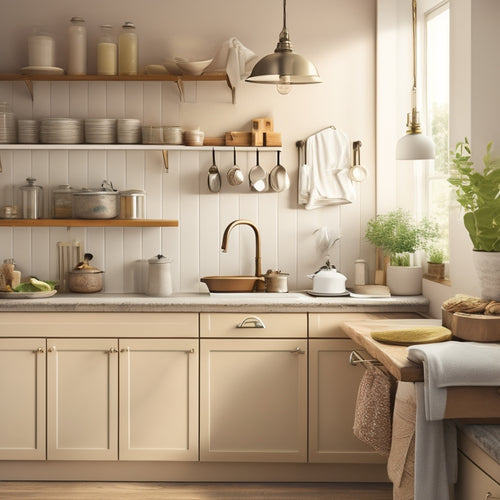
3 Essential Kitchen Layout Tips for Home Cooks
Share
You'll cook up a storm with a well-designed kitchen layout. First, optimize your workflow by strategically positioning work zones, mapping out paths between sink, stove, and fridge, and ensuring ample counter space for food prep. Next, create zones for specific tasks, like a dedicated area for meal prep, to stay organized and efficient. Finally, maximize storage and accessibility by assigning a home to every item and incorporating built-in storage options in islands. By implementing these three essential tips, you'll be whipping up meals in no time - and discovering even more ways to make your kitchen workflow smoother.
Key Takeaways
• Strategically position work zones to reduce congestion and bottlenecks in the kitchen.
• Divide the kitchen into dedicated zones for specific tasks, like chopping or cooking, to stay organized and efficient.
• Assign a home to every item in the kitchen, ensuring what you need is always within easy reach, to maximize storage and accessibility.
• Form a "golden triangle" with the sink, stove, and refrigerator to optimize workflow and reduce time spent on meal prep.
• Incorporate built-in storage options, such as carousels or lazy Susans, to optimize real estate in the kitchen and keep frequently used items within easy reach.
Optimizing Workflow and Efficiency
By strategically positioning your kitchen's work zones, you can shave precious minutes off meal prep time and transform your cooking experience into a seamless, stress-reducing routine.
To achieve this, pay attention to traffic patterns in your kitchen. Identify the paths you and others take when moving between the sink, stove, and refrigerator – the three most frequently used areas. By mapping out these traffic patterns, you can optimize the layout to reduce congestion and bottlenecks.
Next, consider the counter space around each zone. Make sure there's ample room for food preparation, cooking, and cleaning. A well-designed layout should allow you to move freely between zones without feeling cramped or claustrophobic.
Creating Zones for Specific Tasks
You'll find it helpful to divvy up your kitchen into dedicated zones, each tailored to a specific task, like a prep station for chopping and dicing, a cooking zone for sautéing and roasting, or a cleaning zone for scrubbing and sanitizing. This approach will help you stay organized, focused, and efficient while cooking. By creating separate areas for different tasks, you'll avoid clutter and chaos, making meal prep a breeze.
Here's a breakdown of the different zones you can create in your kitchen:
| Zone | Tasks | Essentials |
|---|---|---|
| Prep Station | Chop, dice, slice | Cutting board, knives, utensils |
| Cooking Station | Sauté, roast, boil | Stovetop, oven, cookware |
| Cleaning Zone | Wash, sanitize, dry | Sink, dishwasher, cleaning supplies |
| Storage Zone | Store ingredients, cookware | Cabinets, pantry, shelving |
Maximizing Storage and Accessibility
Optimize your kitchen's real estate by assigning a home to every item, from spices to cookware, ensuring that what you need is always within easy reach. This means carefully considering the layout of your storage spaces to maximize accessibility.
For instance, corner cabinets can be tricky to navigate, but installing a carousel or lazy Susan can help you make the most of this often-wasted space.
When it comes to your island, think about incorporating built-in storage options like drawers, shelves, or cabinets. This won't only keep your countertops clear but also provide a convenient place to stash frequently used items.
Consider the 'golden triangle' concept, where your sink, stove, and refrigerator form the points of a triangle, and position your most-used items within this zone for easy access.
Frequently Asked Questions
How Do I Choose the Right Kitchen Layout for My Cooking Style?
You identify your cooking personality by reflecting on your habits, then visualize your ideal kitchen flow, considering the 'work triangle' concept, to create a liberating space that harmoniously navigates your culinary style.
Can I Have a Functional Kitchen With a Small Floor Plan?
"Craving a culinary haven in a compact space? You can! By embracing space-savvy strategies and compact design, you'll craft a functional kitchen that flows freely, liberating you to cook up a storm, even with a small floor plan."
What Are Some Popular Kitchen Layout Styles and Their Benefits?
You'll love the Galley layout's benefits, like efficient workflow and ample counter space, while the Peninsula style offers advantages like defined zones and increased seating, both perfect for maximizing your small kitchen's potential.
How Do I Incorporate a Kitchen Island Without Obstructing Traffic?
You're craving freedom in your kitchen, but a clumsy island can suffocate the space. Place it strategically, considering traffic flow, to create a harmonious hub where you can whip up a storm without bumping into obstacles.
Are There Any Kitchen Layout Considerations for Left-Handed Cooks?
As you design your kitchen, consider left-handed ergonomics, placing frequently used items on the left side of your workspace. Opt for ambidextrous design, ensuring your layout flows smoothly, regardless of handedness, giving you the freedom to cook with ease.
Related Posts
-

5 Best Kitchen Organization Products for Arthritis Relief
You're looking for ways to make meal prep easier on your joints. Arthritis can make kitchen tasks a struggle, but the...
